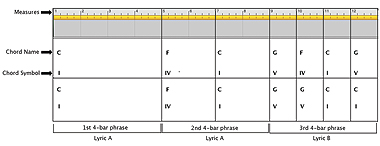Home | Audio | DIY | Guitar | iPods | Music | Brain/Problem Solving | Links| Site Map
This work is licensed under a Creative Commons License.
Composing with the Blues
By Stefani Langol
Apr 1, 2005 12:00 PM
The Electronic Musician
The 12-bar blues is a wonderful vehicle for teaching composition. In this lesson, our goals are to give students a historical framework of the blues, provide a basic knowledge of the 12-bar blues form and harmonic progression, and offer the opportunity for students to create their own 12-bar blues songs using any digital audio sequencer (such as Cakewalk's Sonar or Home Studio, Steinberg's Cubase, or Apple's GarageBand). By the end of the lesson, students will record drums, a bass line, an accompaniment part, and a vocal track with original lyrics.
The lesson assumes that students have a basic working knowledge of the software you are using, a basic knowledge of the pentatonic or blues scale, and a familiarity with I, IV, and V chords, basic rhythms, and rhythmic subdivision in 4/4 time. You can also accomplish this project by providing MIDI and audio loops (recorded musical phrases that repeat seamlessly).
FIRST STEPS
Begin by establishing the historical and musical context for the project. There are some excellent teaching strategies and learning resources available on the Internet that you can use to assist with the integration of blues music, its culture, and its history into the classroom (see the sidebar “Blues on the Web”). Incidentally, this addresses MENC National Standard 9, “understanding music in relation to history and culture.”

FIG. 1: Here are two common 3-chord blues progressions, both in the key of C. The key of C is considered a “piano key”; students who play guitar might prefer working in a typical “guitar key” such as D, G, E, or A. |
Create a blues WebQuest for your students to use (see “Lesson Plan: The Wonderful World of WebQuests” in the September/October 2004 issue of MET). WebQuests provide students with an online research experience that will greatly enrich their learning.
Discuss and analyze the basic 12-bar blues form and harmonic progression. A simple 12-bar blues progression typically uses the I, IV, and V chords and consists of three 4-bar phrases (see Fig. 1). Examine several blues lyrics and discuss writing original lyrics for a 12-bar blues. Blues lyrics often tell a story and follow an AAB pattern. Along with illustrating the harmonic progression, Fig. 1 also shows how each section of the AAB lyric scheme relates to the 4-bar phrases of the 12-bar blues form.
CREATING THE TRACKSStudents can create their own 12-bar blues song using a program like GarageBand or Home Studio. Your project should contain at least four tracks: bass, harmonic accompaniment, drums, and lead vocal. You may want the students to add a fifth track for an improvised lead. Students can create these tracks in a variety of ways, and the process will be determined by the teacher's curricular goals.

FIG. 2: This piece, recorded in Apple’s GarageBand digital audio sequencer, includes MIDI tracks, linear audio tracks, and audio loops. |
Tracks can be MIDI recordings, audio recordings, or prerecorded MIDI or audio loops (see Fig. 2). For instance, they could use an electronic keyboard to record the bass, drums, and harmonic accompaniment MIDI tracks, recording the vocals on an audio track. In case you don't have a program like GarageBand or Home Studio that comes with library of loops, there are lots of free MIDI and audio loops available on the Web, as well as numerous, inexpensive loop packages you can purchase (see the sidebar “Free Loops”).
Once the project has been recorded and arranged, students can use the digital audio sequencer's MIDI- and audio-editing tools to make changes or correct mistakes.
FINISHING UPThe next step is to mix the song. Mixing is the art of creating a balance between all the of the tracks in a project. Setting volumes, panning tracks to the left or right, adjusting tone with EQ, and adding effects such as reverb are all part of the mixing process.
Once the project is completed, students should share and evaluate their tunes. If possible, archive their creations by burning a CD or posting the files to the school Web site.
Stefani Langol is a music educator, clinician, author, and consultant. She is currently Assistant Professor of Music Education at Berklee College of Music and also serves as the technology coordinator for the department.
Blues on the WebThe Web is a great source of information on the blues. The sites listed here are just a few examples to get you started.
Blue Highway; www.thebluehighway.com
How the Blues Affected Race Relations in the United States; www.jessicagrant.net/thesis/index.html
PBS History of the Blues; (includes lesson-plan material); www.pbs.org/theblues/classroom.html
The History of Blues Music; http://afroamhistory.about.com/library/weekly/aa030501a.htm
Free LoopsYou can buy some excellent commercial loop libraries, and a number of programs let you create your own loops. But if you look around on the Web, you can also find free, downloadable loops, which can be a real time-saver. Here are a few sites to check out.
Free Loops; www.freeloops.com
Groove Monkee; www.groovemonkee.com/home.php
Looperman Audio Resources; www.looperman.com/loops_samples_menu.php
Partners In Rhyme; www.partnersinrhyme.com
Home | Audio | DIY | Guitar | iPods | Music | Links | Brain and Problem Solving | Site Map | Contact